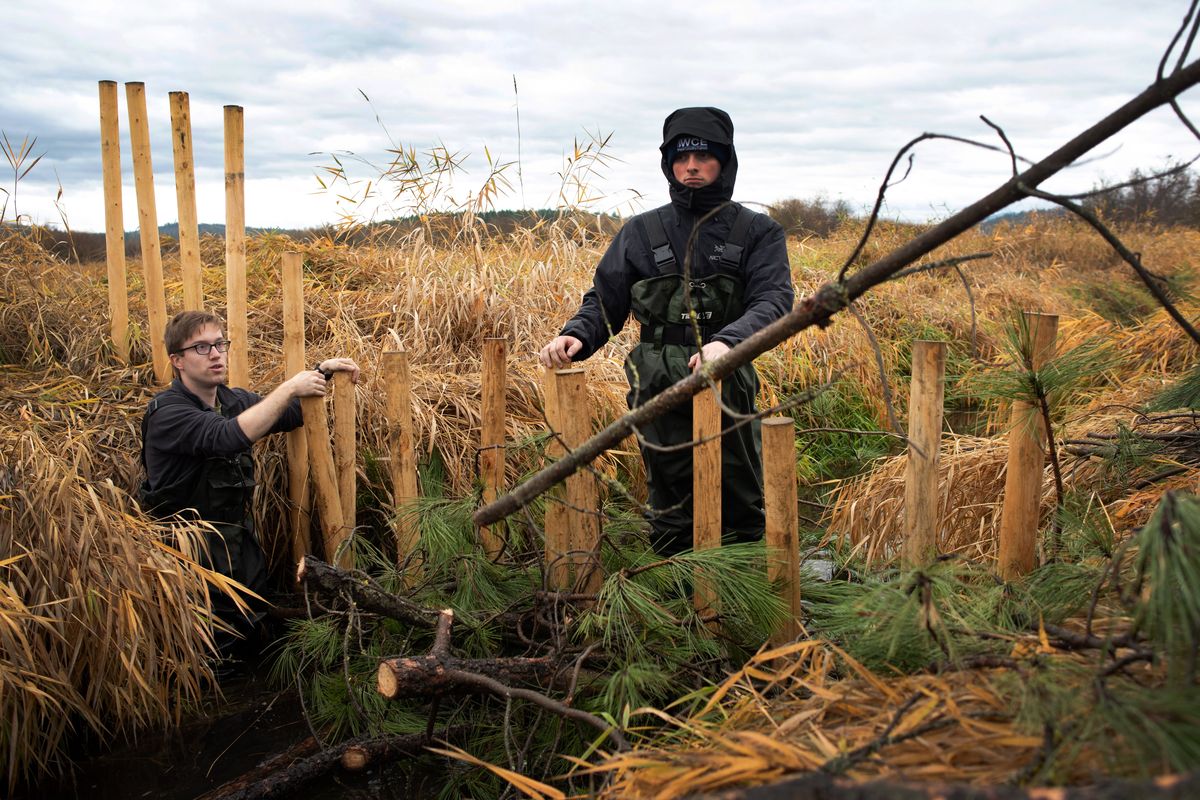In hopes of reducing phosphorous in Newman Lake, Gonzaga students, Lands Council install beaver dam analogs

On an overcast afternoon, 20 Gonzaga University seniors garbed in waders did what they could to mimic beavers. The students, all seniors in civil engineering, wove pine boughs between poles driven into the bed of Thompson Creek, north of Newman Lake on Oct. 28.
The endeavor – a partnership among Gonzaga University, the Lands Council, the Newman Lake Property Owner’s Association and the Inland Northwest Lands Conservancy – is aimed at slowing down the water in Thompson Creek and improving the health of Newman Lake.
The students were in Sue Niezgoda’s civil engineering class and were helped by Kat Hall, the restoration program director for the Lands Council.
Together, they’re building beaver dam analogs, devices that mimic beaver dams and which should slow the downward rush of Thompson Creek, which flows from its headwaters near Mount Spokane.
Thompson Creek rushes now, a nearly straight waterway. But like most creeks and rivers it once meandered, flooding its banks seasonally, the water hampered by beaver dams and other obstacles. Starting in the late 1800s as European settlers came to Newman Lake, Thompson Creek was straightened to control annual flooding and for agricultural purposes.
That increased the water’s velocity, which in turn deepened the creek bed and lowered the water table. At the same time, the removal of obstacles meant that pollutants, like phosphorous, were not captured in sediment, instead flowing directly into Newman Lake.
In fact, Thompson Creek has been marked as the single-largest yearly input of phosphorous into Newman Lake – 43% according to a Washington State Department of Ecology report from 2007. That phosphorous has spurred the growth of algae and other invasive aquatic weeds, which in turn has forced the state to close and treat the lake with weed killer on and off since the 1980s. In each of the past five years, there have been algae warnings issued for the lake.
The deterioration of the lake’s health has been distressing for lake residents and lovers.
“I want to see it taken care of,” said LeAnn Gould, a member of the Newman Lake Flood Control Zone district advisory board.
Gould’s great-grandfather built a cabin on Newman Lake in 1906. Growing up spending summers there, she’s seen the sleepy rural area grow. According to a Spokane Conservation District study, the Newman Lake watershed had 400 full-time residents and 1,800 summer residents in 1973. Today, about 17,000 people live in the watershed.
About two years ago, Gould was talking to Dawson Matthews about Newman Lake’s overall health and, in particular, the phosphorous pollution.
“What we’re trying to do is grapple with what appears to be the declining water quality,” Gould said.
Matthews, an environmental program and flood plains engineer with Spokane County, recommended Gould reach out to the Lands Council and ask specifically about beaver dam analogs.
“The county took a backseat on this,” Dawson said, emphasizing that the Lands Council, homeowners and Gonzaga have taken the lead.
Known as BDAs, the basic idea is simple: They slow the flow of water and allow the build up of sediment to fill in incised streams. Some stream beds, like Thompson Creek, are so deeply cut and the water level so low, that the surrounding land can’t support native tree and plant life, which in turn means beavers can’t live there.
BDAs begin that healing process. Research has shown that BDAs can have a wide range of positive impacts, on the reduction of pollutants but also on general habitat restoration. In Oregon, BDAs have restored destroyed or degraded steelhead habitat, and studies in Nevada have shown a general increase in vegetation following the installation of BDAs.
All of which explains why these Gonzaga students are standing hip deep in the stream, weaving pine through wooden posts and then compacting them by stomping on them, a movement Kat Hall terms “the BDA dance.”
“We want this to be kind of random,” Hall said to the assembled Gonzaga students. “We want it to be a little bit messy.”
One big benefit of BDAs is they are cheap. The pine boughs came from other Lands Council fuel reduction projects, Hall said.
The U.S. Fish and Wildlife Service provided a post pounder to drive the wooden stakes into the streambed.
In total, the 18 BDAs that have been built along Thompson Creek cost less than $6,000.
The BDAs are on private land (which was once grazed by cattle). Gonzaga students will continue to monitor the project area to see how the BDAs are impacting phosphorous levels by taking samples from different areas of the stream.
Niezgoda is also hoping the BDAs expand the flood plain and reconnect the creek to the stream’s old, now empty, side channels.
“It was a slam dunk,” Gould said. “The whole thing is getting paid for by grants. And it is at least something you can do. When your water quality is going bad, and you have limited funding, you are going to do everything you can.”